
Bora Bora’s Modern Rebirth
The quintessential, once-in-a-lifetime destination has evolved. Staying true to its natural assets, today the postwar paradise is revered for much more than the overwater honeymoon suites that put it on the map in the 1960s.
Since the earliest explorers first laid eyes on this speck of Eden in the South Pacific, its striking beauty and impossibly chic resorts have solidified it as one of the most aspirational destinations on Earth. Rich volumes of discovery stories belong to these little islands on the outer edges of the world. When Australian aboriginal people joined forces with explorers from Taiwan around 1000 BC, they started migrating into what is now Melanesia. By the time they perfected ship building and learned new techniques for storing food, they set sail going east and arrived around 1000 AD in Polynesia, meaning “many islands.” Neighboring island Raiatea became the spiritual heart of the islands, from where explorers embarked on their sails, heading north to Hawaii, east to Easter Island, and south to New Zealand. These destinations form the Polynesian Triangle: each point 7,000 km away from another, making 21,000 km on all sides, with Bora Bora right in the center.
Fast forward to modern times and it was the Americans who put Bora Bora on the international map. In 1943, during World War II, they built French Polynesia’s first airport, on Motu Mute (“motu” meaning the small flat islets surrounding the lagoon). By 1958, word about this magical destination got out and commercial flights began.
Despite the international influx, cultural ties run deep. Polynesians center their lives around two things: the ground, where you build a house and grow your food; and the water, the gateway to sail, explore, and fish. They read patterns in nature and have an intuitive connection with the animals, most notably the sea turtles, stingrays, and, yes, the sharks. Contrary to Hollywood’s portrayal of sharks, courtesy of Jaws and the wild fear that movie instilled, in Bora Bora, you’ll swim right alongside them.
Sharks are both intelligent and intuitive because of their ability to sense electromagnetic fields under water. If there’s a sick fish somewhere, they’ll feel it. If a swimmer projects fear, they’ll sense it. When they come close and feel your energy, it’s like they get tickled and they enjoy it. And when they smell blood, even from very far away, they can identify human blood and know such prey doesn’t taste good. So, when you jump in the water with your snorkel and find a dozen blacktip reef sharks circling you, or when a family of stingrays wants to give you a hug or swim through your legs, have no fear. They’re welcoming you into their world.
Today, Bora Bora looks to the future, believing both environmental conservation and high-end tourism work hand in hand. What’s alive and well is the respect required to make authentic connections with visitors. Tahitians with traditional Polynesian tattoos help run the finest resorts and authentic wood-carved tikis adorn the chicest overwater bungalows. The era of Bora Bora as the honeymoon hideaway has passed, and stepping forth is a dynamic destination for jet setters and adventurers alike, a natural playground revealing the truest sense of place where human connections are made, and people keep coming back.
At dusk, every shade of blue floats side by side with the rich, sun-kissed golden glow of thatch bungalows. The full moon rises from the reef, ascending gently and confidently, illuminating the lagoon with a silver shimmer, guiding the island tides after sunset’s final performance. The rhythmic sound of waves crashes from beyond the motu and Bora Bora takes her seat in the South Pacific spotlight.
GETTING THERE
Air Tahiti Nui (airtahitinui.com) flies direct from LA, Tokyo, Auckland, and Paris daily with brand-new 787 Dreamliners, making an easy eight-hour hop from LAX to the Tahitian islands that much more comfortable. Regional Air Tahiti (airtahiti.com) jets make the short hop to Bora Bora and the rest of French Polynesia.
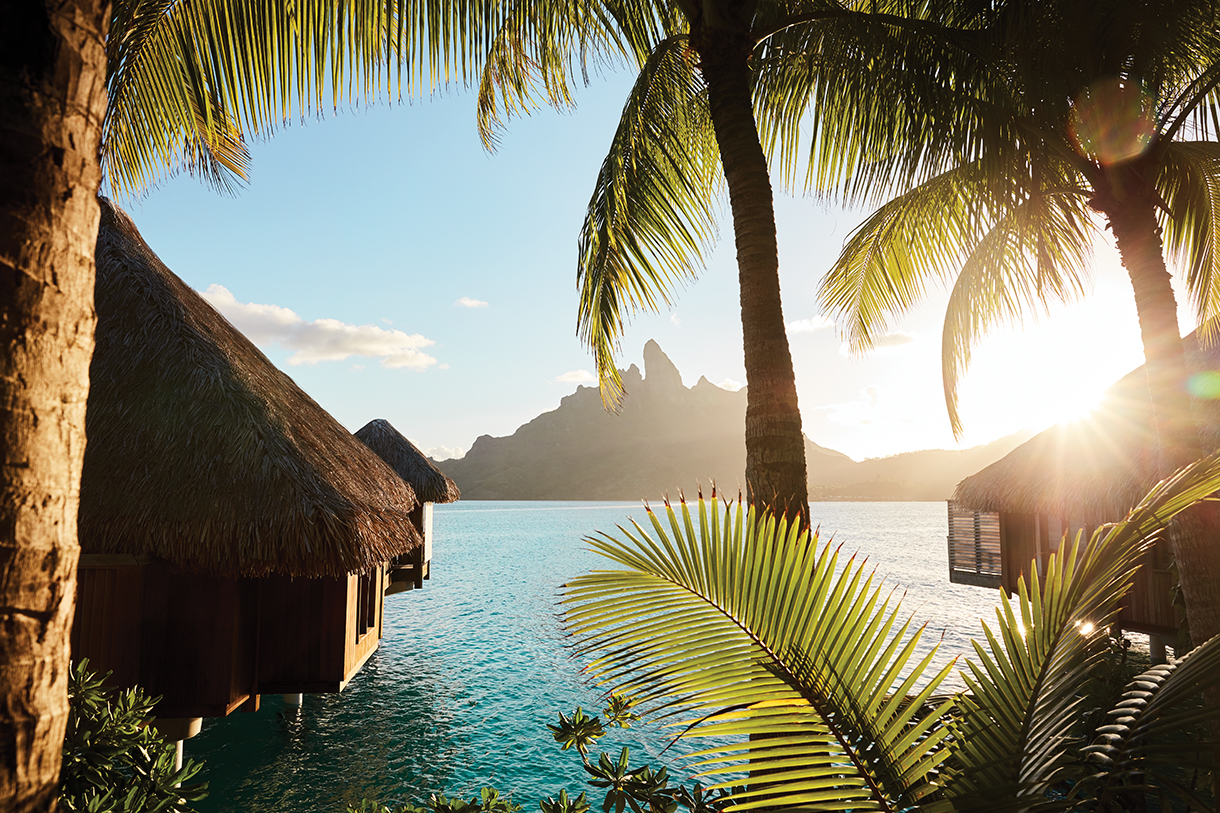
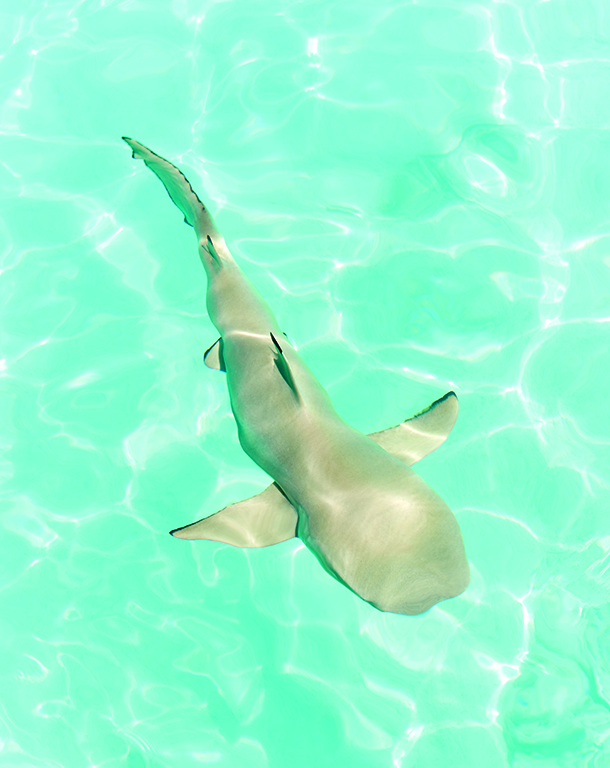
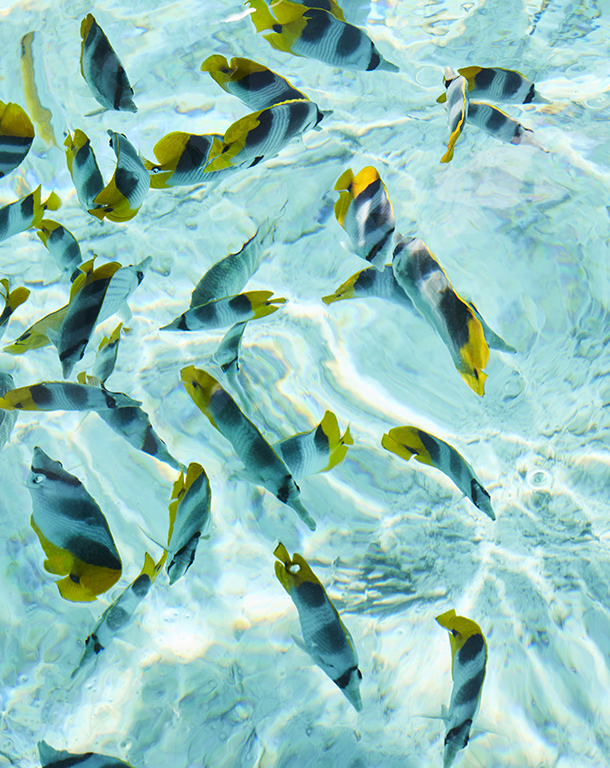
WHERE TO STAY – ST. REGIS RESORT, BORA BORA
Since 2006, St. Regis Resort, Bora Bora has set the high-end standard. Built across 44 acres and four motus are 77 overwater bungalows and 13 one- and two-bedroom beachside villas with the subtle sophistication of dark-wood interiors and high coral walls. The largest accommodation on property is The Royal Estate Villa, a sprawling, 13,000-square-foot, three-bedroom compound accommodating nine guests. At its center, an open-air pool and sundeck are surrounded by a private chef’s kitchen, a dining room, spacious lounge areas, and a light-filled solarium facing your own private beach.
Dining: Lagoon by Jean-Georges is Bora Bora’s showcase for gastronomic innovation. Guests from all over the island make the seafaring pilgrimage to experience their signature uravena, a rare deep-sea fish cooked to perfection with Tahitian passion fruit sauce. This is the only place in Polynesia where it can be eaten, and it’s worth the trip.
Te Pahu serves an unbeatable breakfast and lunch in a laid-back beach setting. Every Wednesday night, guests are treated to a traditional Polynesian show of fire dancing and drum music.
Wellness: Signature Polynesian massages at the Iridium Spa are done with Tahitian monoi oil, a blend of coconut oil, and local scents like the tiare flower and vanilla grown on neighboring Taha’a. Medicinal oils like noni and papaya are used to heal sunburns, and dark rich scrubs made with real black pearl powder and tiare oil are available to purchase.
Activities: All guests enjoy 24-hour butler service, and concierges can arrange day trips around the island. The Shark and Ray Tour is a highlight. For a subtle glimpse of local sea life, a daily fish feeding at the resort’s own Lagoonarium is held each morning with the resident biologist. For those wanting for retail therapy, the Robert Wan Pearl Boutique features the finest black pearls the islands can offer. From $1,200; stregis.com
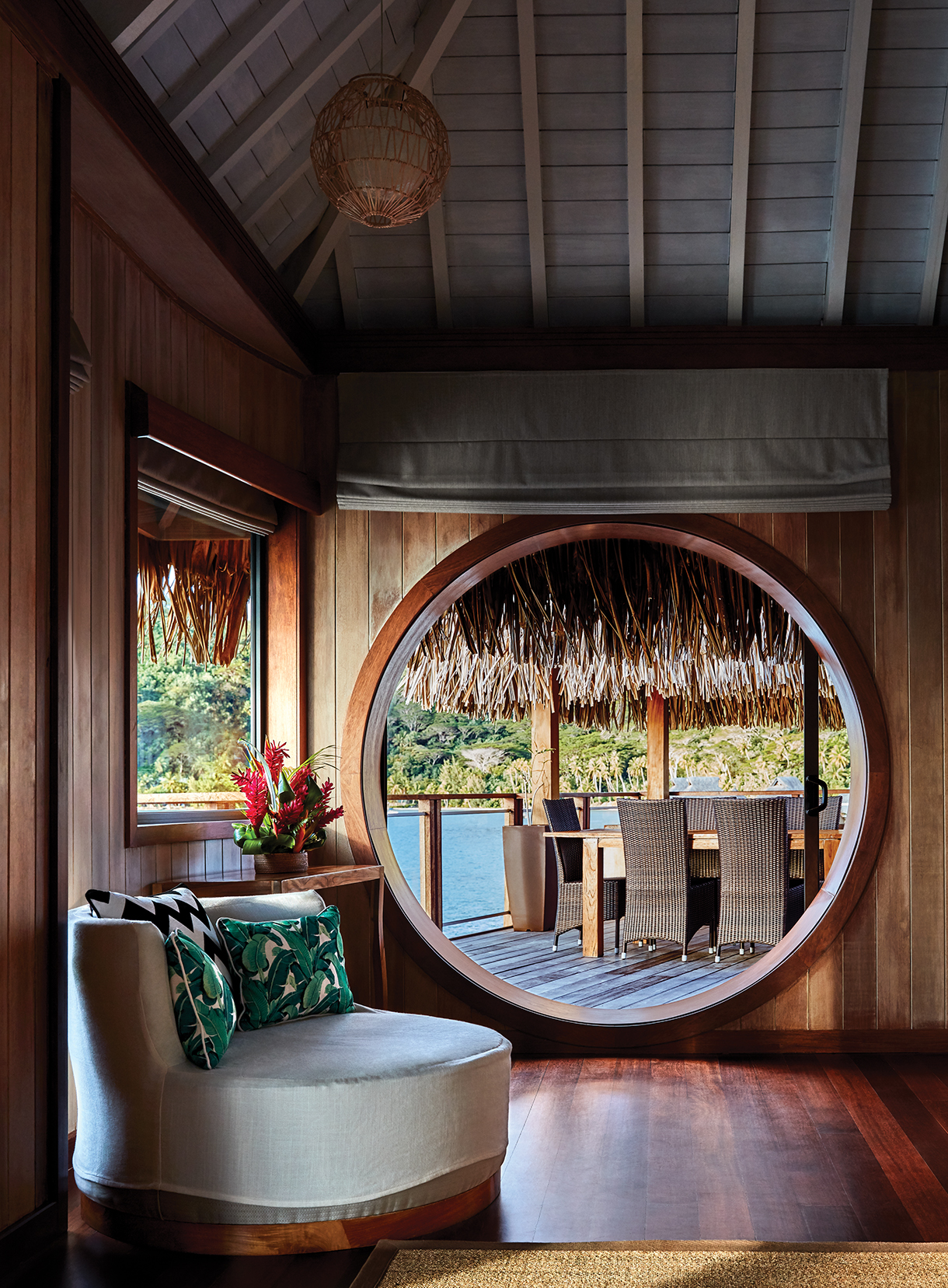
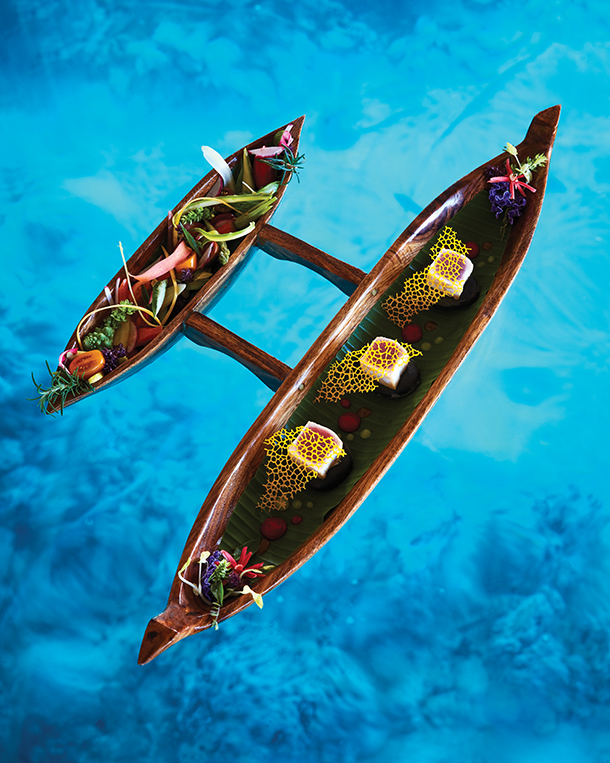
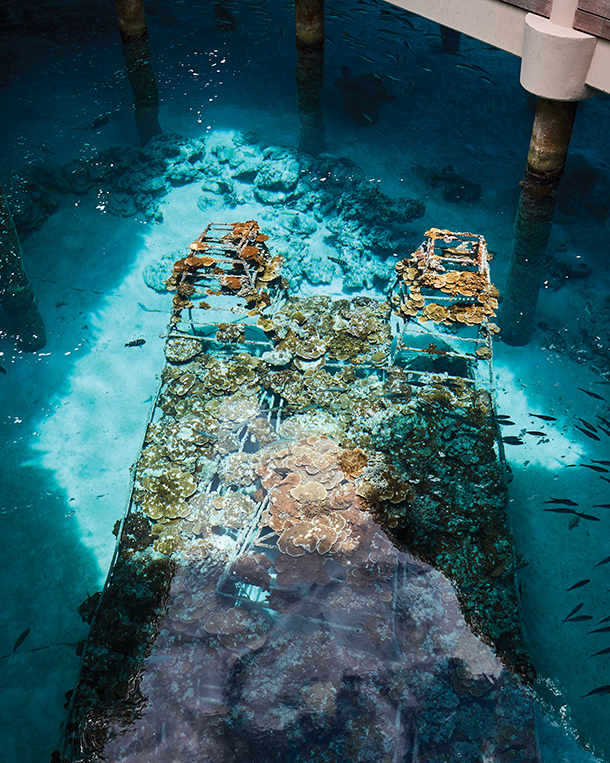
WHERE TO STAY – CONRAD BORA BORA NUI
The newly renovated Conrad Bora Bora Nui, located in a hillside botanical garden on Motu To’opua, is the newest resort on the island and attracts a young and energetic clientele. The 86 overwater bungalows and 28 villas are decorated with a bright beach house aesthetic. Two double-story, 3,200-square-foot Presidential Bungalows sit at one end of the property and feature two bedrooms, private infinity pools, hot tubs, and saunas. At the motu’s other end are two one-bedroom, sunrise-facing Royal Villas.
Dining: Iriatai French Restaurant is where French and Polynesian flavors meet. Beautifully executed presentations aside, Chef Kevin Mougin elevates freshness to an inspiring level. An international breakfast buffet is served here in the morning, featuring Polynesian specialties like homemade pineapple pa’i cake and coconut ipo bread. Banyan Chinese Restaurant, named for the beautiful old tree it sits beside, is where guests enjoy steamed dumplings, Singaporean noodles, and exotic desserts.
Wellness: The Hina Spa, named after the Tahitian goddess of beauty, sits hilltop upon black volcanic rocks. The spiritual energy is strong here and a variety of traditional treatments including Tahitian and Balinese massages are offered. Treatment rooms have sweeping views of the motu and gardens and offer the best sunset view in Bora Bora. There’s an exclusive new Le Parfum Conrad by Coqui Coqui, the top Polynesian perfumer in the world.
Activities: The Conrad’s greatest promise to the island is to keep the local culture alive. The activities desk can organize any day trip around the island and can even take you to a secret spot of loca l legend. Black volcanic rocks are unique to this motu, and one in particular is known as Hiro’s Bell. Hiro, a fearless warrior in Polynesian mythology, is said to have chopped off the top of Mount Otemanu in a fit of jealous rage. From $800; hilton.com
BioRock: Climate change and mass tourism have taken their toll on Bora Bora’s coral reef. The Conrad has teamed up with Espace Bleu and the Global Coral Reef Alliance to combat the loss by building BioRock to reintroduce coral and its wildlife back around the resort. A low-voltage electrical current adheres mineral crystals in seawater to an underwater conductive structure, creating a new home for a full range of coral reef sea life. If the current is maintained, reefs can be restored in areas once thought impossible. The first turtle-shaped BioRock at the resort can be seen from the pontoon of the Upa Upa Lounge Bar.

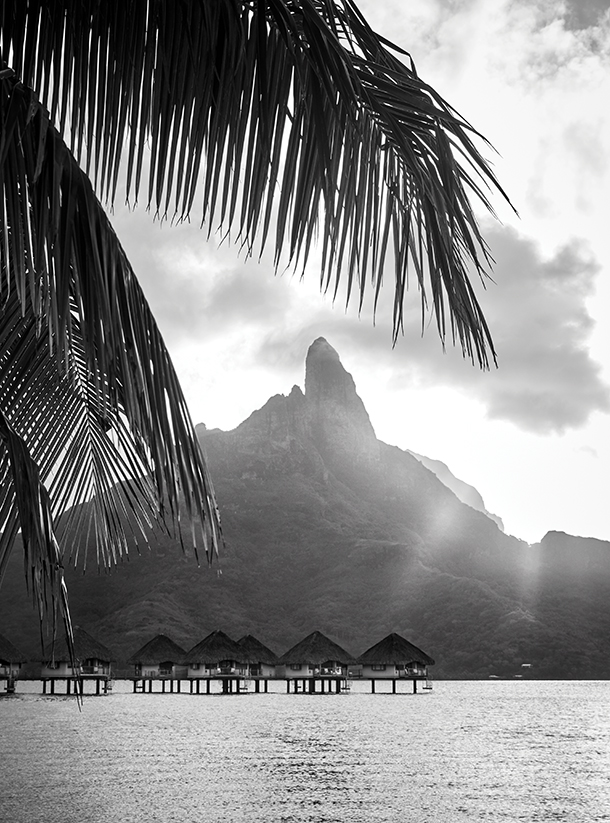
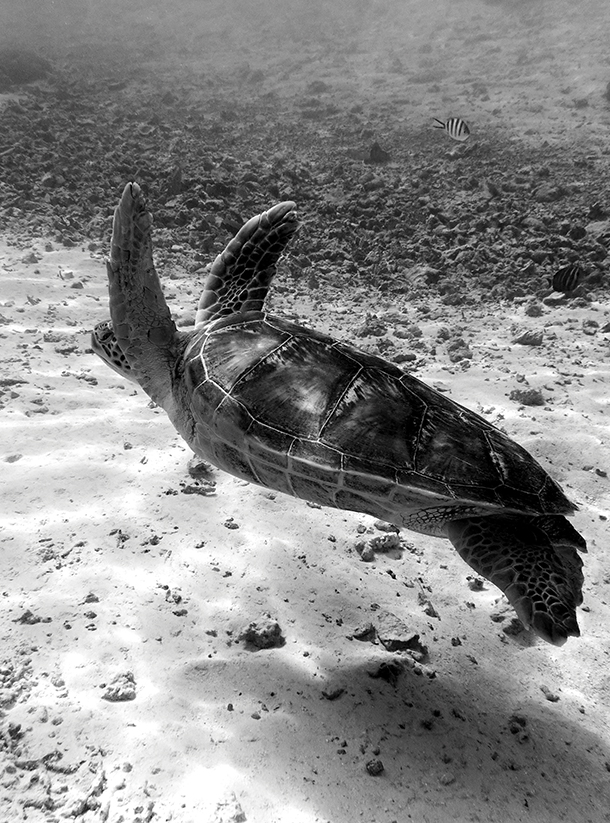
WHERE TO STAY - Le Méridien Bora Bora
Le Méridien Bora Bora has some of the most unique accommodations for every kind of traveler, including 82 cozy overwater bungalows with the largest glass-bottom floors in French Polynesia. There are also 12 intimate beach bungalows and four spacious family-sized beach villas with private pools. The warm, shallow lagoon waters are literally at your doorstep, as is every aquatic activity from snorkeling to kayaking to traditional Polynesian pirogue sailing.
Dining: Le Tipanie Restaurant offers a sprawling breakfast buffet each morning, with fresh local juices, homemade jams and honey, and a romantic dinner menu each night, set right on a private lagoon. Te Ava Restaurant is a laid-back, feet-in-the-sand lunch spot with what is hands-down the best poisson cru in Bora Bora (fresh ahi tuna marinated in coconut milk; the national dish of French Polynesia).
Hapaina Wine Bar is where to go for a modern wine-tasting experience, featuring Vin de Tahiti, a local wine made in Rangiroa by a family from Burgundy. A private candlelit tasting menu on the beach can also be arranged for a romantic evening or a large family celebration.
Activities: A visit to the resort’s Ecological Center is a must for any visitor to the island. The project began in 2000, when an injured sea turtle was brought to the hotel by a guest, and Le Méridien Bora Bora has since invested an enormous amount of time and funding to the care and preservation of its local sea life. The center and its successes are known throughout French Polynesia. From $750; marriott.com
Turtle Sanctuary: Humans are the biggest threat to the three sea turtle species found in French Polynesia: Green, Hawksbill, and Leatherback. With plastics filling our oceans, many turtles ingest bottle caps, PVC pipes, and plastic bags. Regional poaching is also a threat, not for shells but for turtle meat, which is sold on the black market. Many injured sea turtles are found by locals and fishermen, and brought to Le Méridien’s Turtle Sanctuary, a rehab facility where biologists Teiva, Tonin, and Anale remove plastic from their systems, give them a safe home to heal, and ideally release them back into the sea. Working in cooperation with the government, they successfully released 43 turtles back into the wild last year. From energetic babies to 3-foot-long adults, visitors can enjoy the daily Turtle Feeding. You can also get a closer look and lend hands-on support during the daily Healing Hour.




